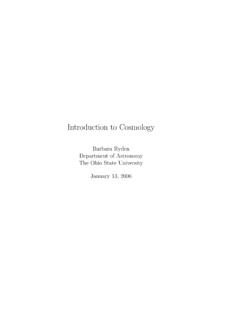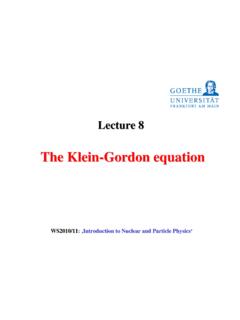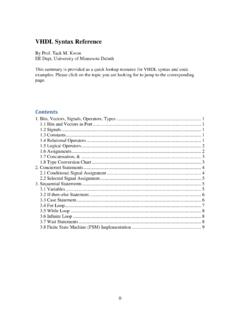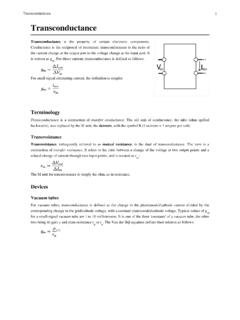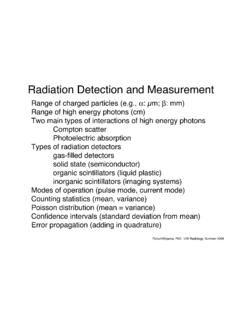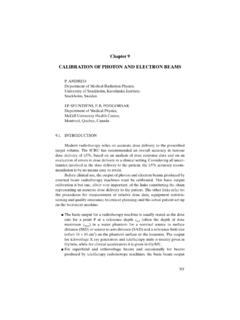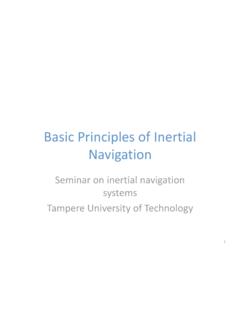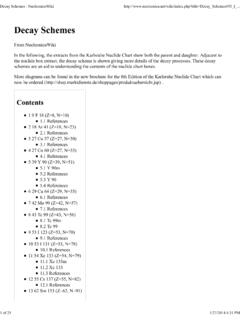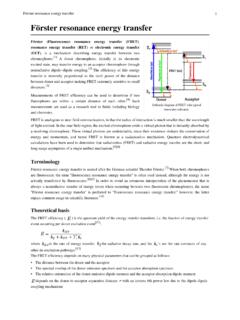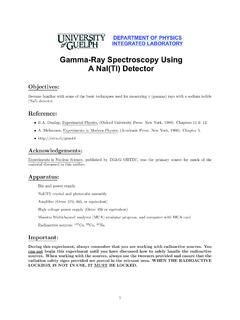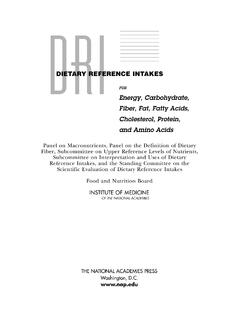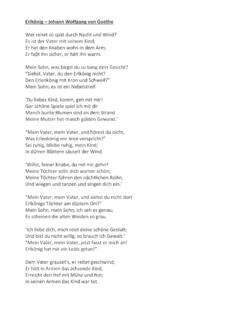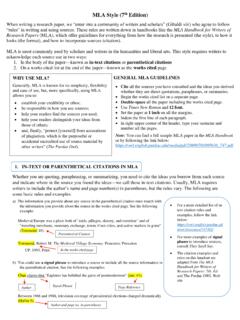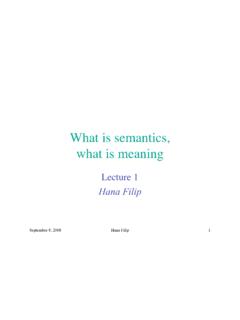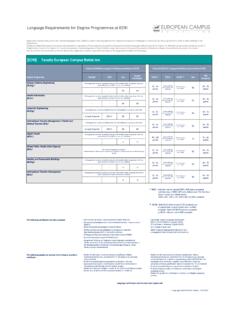Transcription of Lecture 4 Scattering theory - University of Arizona
1 1 Lecture 4 Lecture 4 Scattering theoryScattering theorySS2011SS2011: : Introduction to Nuclear and Particle Physics, Part 2 Introduction to Nuclear and Particle Physics, Part 2 2I. Scattering experimentsI. Scattering experimentsScattering experiment:A beam of incident scatterers with a given fluxor intensity (number of particles perunit areadAper unit timedt ) impinges on thetarget(described by a Scattering potential); the flux can be written asThe number of particles per unit timewhich are detected in a small region of the solid angle, d ,located at a given angular deflection specified by ( , ), can be counted as3 Scattering cross sectionScattering cross sectionThe differential cross-sectionfor Scattering is defined as the number of particles scattered into an element of solid angle d in the direction ( , )per unit time :Thetotal cross-sectioncorresponds to scatterings through any Scattering angle.
2 [dimensions of an area]( )( ) ddNJ1d),(dscinc=Most Scattering experimentsare carried out in the laboratory (Lab) framein which thetarget is initially at rest while the projectiles are moving. Calculations of the cross sectionsare generally easier to perform within the center-of-mass (CM) framein which the centerof mass of the projectiles target system is at rest (before and after collision) one has to know how to transform the cross sectionsfrom one frame into the other. Note:the total cross section is the same in both frames, since the total number of collisions that take place does not depend on the frame in which the observation is carriedout.
3 However, the differential cross sections d /d are not the same in both frames, since the Scattering angles( , )are frame incident flux4 Connecting the Connecting the aanglesnglesin the Lab and CM framesin the Lab and CM framesTo find the connection between the Lab and CM cross sections, we need first to find how the Scattering angles in one frame are related to their counterparts in the denote the position of m1in the Lab and CM frames, respectively, and if denotes the position of the center of mass with respect to the Lab frame,we have A time derivative of this relation leads towhere are the velocities of m1in the Lab and CM frames before collisionandis the velocity of the CMwith respect to the Lab frame.
4 Similarly, the velocity of m1aftercollisionis( )( )Elastic scatteringof two structureless particles in the Lab and CM frames:Note: consider for simplicity NON-relativistic kinematics!L1 CMV||Vrr5 Connecting the Connecting the aanglesnglesin the Lab and CM framesin the Lab and CM frames( )( )Dividing ( ) by ( ), we end up with( )( )( )Since from ( ) or from ( ) L22L11CM21L2L1 CMVmVmV)mm(ppprrrrrr+=++=Use that CM momenta( )( )L1 CMV||VrrSince6 Connecting the Connecting the aanglesnglesin the Lab and CM framesin the Lab and CM framesSince the center of mass is at rest in the CM frame, the total momentabefore and after collisions are separately zero:( )( )( )Since thekinetic energy is conserved.
5 ( )( )In the case of elasticcollisions, the speeds of the particles in the CM frame are the same before and after the collision;From ( ) ( )Dividing ( ) by ( ) 0ppppppC2C1CC2C1C= + = =+=rrrvrr7 Note:In a similar way we can establish a connection between 2and . From ( ) we have+ using the x and y components of this relation areFinally, a substitution of ( ) into ( ) yieldsand usingwe obtainConnecting the Connecting the aanglesnglesin the Lab and CM framesin the Lab and CM frames( )( )( )( )8 Connecting the Lab and CM Cross SectionsConnecting the Lab and CM Cross SectionsThe connection between the differential cross sections in the Lab and CM framescan be obtained from the fact that the number of scattered particles passing through an infinitesimal cross sectionis the same in both frames.
6 What differs is the solid angled :in the Lab frame:in the CM frame:Since there is a cylindrical symmetry around the direction of the incident beamFrom ( ) ( )( )( )( )9 Limiting cases:1)the Lab and CM results are the same,since ( ) leads to 1= 2) then from ( ) from ( ) Connecting the Lab and CM Cross SectionsConnecting the Lab and CM Cross SectionsThus :( )( )From ( ) and ( ) ( )( )10 From classical to quantum Scattering theoryFrom classical to quantum Scattering theory :- Scattering of hard spheres -individual well-defined theory :- Scattering of wave pakeges wave particle duality-probabilistic originof Scattering process11II.
7 Classical tII. Classical trajectoriesrajectoriesand and ccrossross--ssectionsectionsScattering trajectories,corresponding to different impact parameters, bgive different Scattering angles .All of the particles in the beam in the hatched region of aread = 2 bdbare scattered into the angular region ( , +d )The equations of motionfor incident particle:+ initial conditions: defines the trajectorysince initial kinetic energyFor a particle obeying classical mechanics: the trajectory for the unbound motion, corresponding to a Scattering event, is deterministically predictable, given by the interaction potential and the initial conditions.
8 The path of any scatterer in the incident beam can be followed, and its angular deflection is determined as precisely as required( )( )( )12 Classical tClassical trajectoriesrajectoriesand and ccrossross--ssectionsectionsThe number of particles scatteredper unit time into the angular region ( , +d ) with any value of can be written asThe knowledge of b( ),obtained directly from Newton s laws or other methods, is then sufficient to calculate the Scattering the Scattering from nontrivial central forces, the trajectory can be obtained from the equations of motion by using energy- and angular momentum- conservation methods , one can rewritein the formL - angular momentum( )( )( )13 Classical tClassical trajectoriesrajectoriesand and ccrossross--ssectionsectionsThe angular momentum can be written via the angular velocity from ( )
9 The angle through which the particle moves between two radial distances r1andr2 : Scattering trajectories in a central potential :rmin- the distance of closest approach, deflection angleUse that the initial angular momentumand ( )( )( ) from ( ), ( )( )14where the constantcorresponds to the electrostatic interaction of point-like charges Z1e and Z2eClassical Coulomb scatteringClassical Coulomb scatteringThe potential corresponding to the Scattering of charged particles via Coulomb s lawcan bewritten in the general form( ) from ( )( )Note that for large energies (E ) or vanishing charges (A 0), one has rmin bUse that from ( )( )( )
10 15 Classical Coulomb scatteringUse that( ) Rutherford formula -characteristic for Coulomb Scattering from a point-like charge:( )Note:If one attempts to evaluate the total cross-sectionusing Eq. ( ), one obtains aninfinite result. This divergenceis due to the infinite range of the 1/r potential, and the infinity in the integral comes from scatterings as 0 which corresponds to arbitrarily large impact parameters where the Coulomb potential causes a scatter through an arbitrarily small angle, which still contributes to the total Quantum ScatteringIII.
